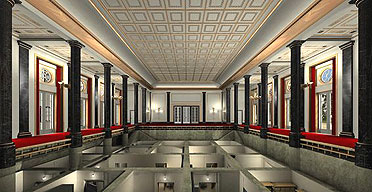· Speer's military academy buried under hill of rubble
· Underground complex reborn as visual tour

Part of the virtual tour of the Führerbunker.
The army academy, designed by Nazi architect Albert Speer, is encased in the Teufelsberg (Devil's Mountain), a 116-metre (380ft)-high mound in Berlin which was constructed from the 26m cubic metres of the capital's wartime rubble.
The unfinished building, for which Nazi leader Adolf Hitler laid the foundation stone in 1937, was meant to become part of Germania, the huge capital of the 1,000-Year Reich. But "war-specific" problems, according to an internal Nazi memorandum, caused building work to be stopped just three years later.
The British occupation forces planned to turn the building into their headquarters, until it proved too difficult to convert. It was also too sturdy to demolish. Instead, half of Berlin's rubble - equivalent to 400,000 buildings - was poured on top, along with grass-seed, and so the Teufelsberg was born.
It has been a favourite place for Berliners to ski and sled in winter and fly kites in summer. The existence of the military college had been virtually forgotten by all but a handful of enthusiasts, until the Association of Berlin Underworlds discovered documents pointing to the academy.
"Most of the faculty must still be intact, despite the attempts to blow it up," said Dietmar Arnold of Underworlds. The association, which has found 50 bunkers in its 10-year existence, is keen to dig down. "We know for sure that underneath there is also a massive multistorey bunker complex."
The plan is to penetrate 20 metres into the north-eastern face with a digger, until it hits concrete and brick and for enthusiasts to enter the mountain with caving equipment. Berlin's press has referred to the mission as an attempt to uncover "the last of the large and undiscovered secrets that underground Berlin has to offer".
Berliners' fascination with its bunkers and hidden wartime structures appears to know no bounds. The most famous, the underground complex from which a crazed Hitler tried to direct the end of the war, has just been "reconstructed" down to the last door handle and window frame in a computer-animated graphic.
Historians have praised the virtual tour of the fortress, which is based on state security records of the 1970s, as the truest existing impression of the bunker. The real bunker, close to Potsdamer Platz, was filled in, buried and built over.
The tour's creator, graphic artist Christoph Neugebauer, said that contrary to the general belief that Hitler spent his last days in a luxurious hi-tech hole in the ground, he was in fact "housed in a fairly run-of-the-mill government workers' bunker".
No comments:
Post a Comment